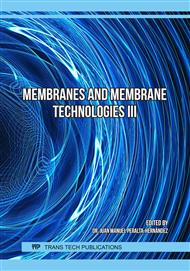p.119
p.127
p.135
p.143
p.151
p.159
p.167
p.173
p.179
Surface Modification of PVDF Membrane Using Formic Acid for Enhance the Hydrophobicity for Desalination
Abstract:
Membrane distillation (MD) is a thermally driven membrane separation process. In recent years, MD is considered as a key technology for desalination applications. It has been proven that it has numerous advantages compared to other desalination processes such as reverse osmosis. The thermal driving force, no osmotic pressure effect on membrane fluxes are among the advantages of this MD process. Membranes fabricated from hydrophobic polymers such as polyvinylidene fluoride (PVDF) can be a great choice for MD for the desalination process. However, MD membranes are still held back by some problems, most notably due to pore wetting effects, thereby limiting their use in treating seawater for desalination propose. This study proposes the use of carboxylic acid to modify the PVDF membrane to increase its hydrophobicity as a solution to avoid wetting in MD for water desalination. As a first step, membrane produced using PVDF pellets under the phase inversion method. Then the membrane underwent modification using 5wt%, 10wt% and 15wt% of formic acid via immersion technique. The characteristics of membrane produced observed by the contact angle, Fourier-transform infrared spectroscopy (FTIR) and membrane performance test. The impact of the concentration of formic acid solution and feed temperature on the membrane was evaluated. The result showed that by modifying the membrane with formic acid resulted in the increase in contact angle from unmodified PVDF membrane, 83.03° to 100.88° when the membrane modified with formic acid with concentration was 10 wt%. It was subsequently shown through FTIR peaks that formic acid successfully modified the PVDF membranes. Highest salt rejection percentage was also obtained with 68.9% when the feed temperature is 60 °C.
Info:
Periodical:
Pages:
151-158
Citation:
Online since:
March 2022
Authors:
Price:
Сopyright:
© 2022 Trans Tech Publications Ltd. All Rights Reserved
Share:
Citation:




